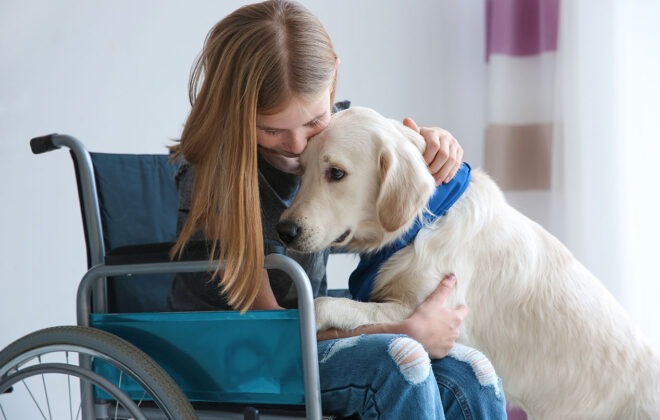Why a Dog Boarding and Training Program Can Be the Best Way to Train Your Dog
Are you struggling to train your dog to behave well in various situations? Do you feel embarrassed, frustrated, or even scared when your dog misbehaves, such as barking excessively, jumping on people, pulling on the leash, or acting aggressively towards other dogs or people? Do you wish that your dog could learn to be more obedient, responsive, and calm, without losing its unique personality and spirit?
If you answered yes to any of these questions, you’re not alone! Many dog owners face similar challenges, and some may even give up on their dogs or resort to punishment or force, which can worsen the situation and damage the bond between the dog and the owner.
Luckily, there’s a better way to train your dog! One that can address the root causes of your dog’s unwanted behaviors and teach your dog how to think proactively, not reactively. This can be achieved through a dog boarding and training program, which offers several benefits over other types of training, such as group training or private training sessions.
In this post, we’ll explain what a good dog boarding and training program should focus on, the differences between proactive thinking and reactive behaviors, and the behaviors that can be fixed in a boarding and training program. We’ll also discuss the use of science-backed data and expert knowledge to solve the common problems that dog owners face, and show how a dog boarding and training program can help.
Why other types of dog training may not work well.
If you’ve tried other types of dog training, such as group classes or private sessions, you may have found that they don’t always work well for your dog or your needs. Here are some common problems with those types of training:
- Group classes may not offer personalized attention, which means that your dog may not get the individual feedback and guidance they need to improve. Group classes may also expose your dog to distractions or triggers that can make the training harder or even counterproductive. For example, if your dog is reactive towards other dogs, being in a group of dogs may heighten her arousal and make it harder to learn.
- Private sessions may be more expensive and less social than group classes, which may make them less accessible or enjoyable for some dog owners. Private sessions may also focus on correcting the symptoms of your dog’s unwanted behaviors, such as barking or jumping, without addressing the underlying causes, such as anxiety or lack of impulse control. As a result, your dog may learn to suppress its behaviors but not to replace them with more appropriate ones.
- Both group classes and private sessions may not provide enough time or consistency to train your dog thoroughly or to reinforce the training over time. If you only train your dog for a few hours a week, or for a few weeks, your dog may not have enough opportunities to practice and internalize the new behaviors or to generalize them to different contexts or situations.
Why a dog boarding and training program can be the best way to train your dog.
So, what’s the solution? We believe that a dog boarding and training program can be the best way to train your dog, for several reasons:
- A good dog boarding and training program should provide your dog with personalized attention, feedback, and guidance from a professional trainer who has experience and qualifications in dog behavior and training. The trainer should also use positive reinforcement and humane methods to teach your dog how to behave proactively, not reactively, which means that your dog should learn to make good choices on their own, without being prompted or corrected all the time.
- This type of program should also offer your dog enough time, consistency, and repetition to learn and internalize the new behaviors and to generalize them to different contexts and situations. By staying in the facility for a certain period, such as two to four weeks, your dog can receive daily training sessions, socialization, exercise, and rest, which can help to reinforce the training and to shape your dog’s behavior in a more holistic and positive way.
- While boarding and training, we can also address a wide range of behaviors that may be challenging for you and your dog, such as hyperactivity, leash pulling, dog aggression, human aggression, disobedience, jumping, and house soiling. A trainer can work with your dog one-on-one or in a controlled environment with other dogs or people, depending on your dog’s needs and progress, and can customize the training plan to suit your dog’s temperament, age, breed, and lifestyle. The trainer can also provide you with updates, feedback, and support, to help you understand your dog better and to reinforce the training at home.
- These programs can also benefit you as a dog owner, by relieving you of the stress, time, and effort required to train your dog on your own, and by giving you peace of mind that your dog is in good hands and making progress. You can also learn from the trainer and from your dog’s behavior, by observing how the trainer works with your dog and how your dog responds to the training. You can also receive guidance on how to maintain and improve your dog’s behavior after the training, and how to prevent or manage future behavior problems.
Solution: How to choose a good dog boarding and training program and how to get help.
If you’re interested in a dog boarding and training program, you should do your research and choose a facility that meets the following criteria:
- The facility should have a good reputation, based on customer reviews, referrals, and display of expertise.
- The facility should have a qualified and experienced trainer, or more preferably, a behaviorist, who uses positive reinforcement and balanced training methods, and who has a clear and transparent training plan and philosophy. The trainer should also be able to communicate effectively with you and to provide you with regular updates and feedback.
- The facility should provide a safe, clean, and comfortable environment for your dog, with proper supervision, nutrition, exercise, and rest, and with access to appropriate equipment, toys, and activities.
- The facility should also have clear policies and procedures for managing emergencies, such as medical issues, accidents, or escapes, and for addressing your concerns or complaints.
If you need help with your dog’s behavior, or if you have any questions or comments about this post, feel free to contact us on Facebook or by phone at (308) 455-0235. We offer a range of dog training services, including dog boarding and training, private training, group classes, and behavior consultations, and we have years of experience and expertise in dog behavior and training. We also have a blog and a website, where you can find more information and resources on dog training and behavior. We look forward to hearing from you and to helping you and your dog achieve a better and happier relationship.
BE SURE TO CHECK OUT OUR 150+ 5-STAR REVIEWS HERE!
In summary, using a dog boarding and training facility can provide the ideal environment for your dog to learn proactive thinking versus reactive behaviors. With science-backed training methods and an experienced trainer, many of the behaviors you struggle with as a dog owner can be addressed and resolved. So, don’t give up on your dog, instead consider a dog boarding and training program and see the progress for yourself.
Related Posts
Leave a Reply Cancel reply
You must be logged in to post a comment.
Search our site
Categories
- Confessions of a Bad Dog Owner Column (1)
- Inspiration (1)
- Medical (3)
- Products We've Reviewed (1)
- Tips & tricks (8)
- Uncategorized (3)



